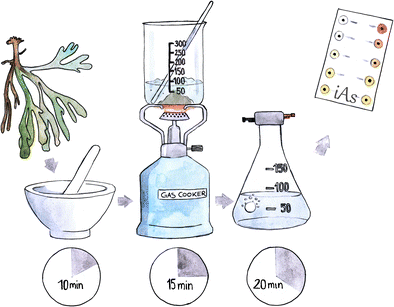
|
|||||
|
|
A field deployable method for a rapid screening analysis of inorganic arsenic in seaweed |
|
| Authors: | Edi?Bralatei,Karolina?Nekrosiute,Jenny?Ronan,Andrea?Raab,Evin?McGovern,Dagmar?B.?Stengel,Eva?M.?Krupp,Joerg?Feldmann mailto:j.feldmann@abdn.ac.uk" title=" j.feldmann@abdn.ac.uk" itemprop=" email" data-track=" click" data-track-action=" Email author" data-track-label=" " >Email author http://orcid.org/---" itemprop=" url" title=" View OrcID profile" target=" _blank" rel=" noopener" data-track=" click" data-track-action=" OrcID" data-track-label=" " >View author&# s OrcID profile |
| Affiliation: | 1.TESLA (Trace Element Speciation Laboratory), Department of Chemistry,University of Aberdeen,Aberdeen,UK;2.Marine Institute,Oranmore,Ireland;3.Botany and Plant Science, School of Natural Sciences, Ryan Institute for Environmental, Marine and Energy Research,National University of Ireland Galway,Galway,Ireland |
| Abstract: | Inorganic arsenic (iAs) in 13 store-bought edible seaweed samples and 34 dried kelp (Laminaria digitata) samples was determined by a newly developed, field-deployable method (FDM) with the aid of a field test kit for arsenic in water. Results from the FDM were compared to results from speciation analysis achieved by using high performance liquid chromatography coupled to inductively coupled plasma mass spectrometry (HPLC-ICP-MS). The FDM consisted of a simple extraction method using diluted HNO3 to quantitatively extract iAs without decomposing the organoarsenicals to iAs followed by the selective volatilisation of iAs as arsine (AsH3) and subsequent chemo-trapping on a filter paper soaked in mercury bromide (HgBr2) solution. Method optimization with a sub-set of samples showed 80–94% iAs recovery with the FDM with no matrix effect from organo-arsenic species in the form of dimethylarsinic acid (DMA) on the iAs concentration. The method displayed good reproducibility with an average error of ±19% and validation by HPLC-ICP-MS showed that the results from the FDM were comparable (slope = 1.03, R2 = 0.70) to those from speciation analysis with no bias. The FDM can be conducted within an hour and the observed limit of quantification was around 0.05 mg kg?1 (dry weight). This method is well suited for on-site monitoring of iAs in seaweed before it is harvested and can thus be recommended for use as a screening method for iAs in seaweed. Graphical abstract Screening seaweed for their inorganic arsenic concentration within one hour without bias has been made possible in the field by using a field deployable arsenic kit. Its accuracy and precision was compared to HPLC-ICPMS. |
| Keywords: | |
| 本文献已被 SpringerLink 等数据库收录! | |
